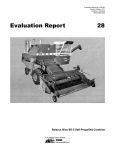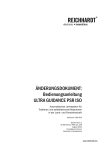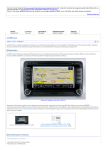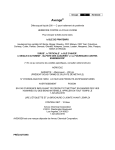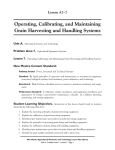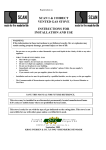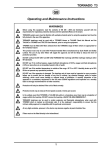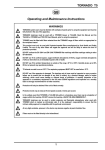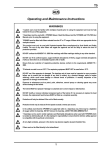Download Evaluation Report 576
Transcript
Tested at: Humboldt ISSN 0383-3445 Group 4c Evaluation Report 576 Don 1500 Self-Propelled Combine A Co-operative Program Between ALBERTA FARM MACHINERY RESEARCH CENTRE PAMI PRAIRIE AGRICULTURAL MACHINERY INSTITUTE DON 1500 SELF-PROPELLED COMBINE MANUFACTURER: Tractoroexport Rostselmash Rostov-On-Don, U.S.S.R. RETAIL PRICE: $109,890.00 (March, 1988, f.o.b. Humboldt, Sask., with a 11.5 ft (3.5 m) pickup on a 13 ft (4.0 m) pickup header, feeder reverser, loss monitor, heater, a/c, and straw chopper). DISTRIBUTOR: Belarus Equipment of Canada Ltd. 225 - 6th Avenue East, P.O. Box 3665 Regina, Saskatchewan S4P 3N8 Phone: (306) 757-5617 FIGURE 1. Don 1500: (1) Cylinder, (2) Concave, (3) Rear Beater, (4) Straw Walkers, (5) Cleaning Shoe, (6) Tailings Return. SUMMARY AND CONCLUSIONS Capacity: In the capacity tests, the MOG feedrate* at 3% total grain loss in Harrington barley was 500 lb/min (13.6 t/h). In wheat crops, combine capacity was 625 lb/min (17.1 t/h) in Columbus wheat and 800 lb/min (21.8 t/h) in Katepwa wheat. In barley, the Don 1500 had approximately 1.35 times the capacity of the PAMI Reference II combine when compared at 3% total grain loss. In wheat, at 3% total loss, the capacity of the Don 1500 was about 1.15 times that of the Reference II combine in Columbus and 1.25 times in Katepwa. Quality of Work: Pickup performance was good. In most crops, it picked cleanly and although it fed the crop quite high on the table auger, no problems were experienced. Feeding was very good. The table auger, front feeder drum and feeder chain were aggressive and seldom plugged. The stone trap provided good stone protection. Some larger stones and roots were stopped between the table auger and front feeding drum. Most stones and roots were trapped in the pocket in front of the cylinder. Stones, which went through the combine, caused minor damage to the concave. Threshing was good. To obtain acceptable unthreshed loss in hard-to-thresh wheat crops, the concave clearance had to be reduced from the factory’s suggested settings, and concave blanks were needed. Grain damage was low in all crops. Separation of grain from straw was good. Straw walker loss was low for canola and flax, but either limited capacity or was a major part of the total loss in wheat and barley crops. Cleaning shoe performance was good. The shoe could be set to achieve acceptable loss in all crops at reasonable feedrates. In some crops, the clean grain sample contained foreign material, which the shoe should have been able to remove. Grain handling was good. The 185 Imperial bushel (6.7 m³) *MOG feedrate (Material-Other-than-Grain Feedrate) is the mass of straw and chaff passing through the combine per unit of time. Page 2 grain tank filled evenly. The unloader, although hydraulically positioned, unloaded only in the fully extended position. A full grain tank of wheat unloaded in about 150 seconds. The tank vibrator aided in unloading damp grain. No straw spreading device was supplied. Ease of Operation and Adjustment: Operator comfort was fair. The cab was quiet and relatively dust free. The air conditioner provided adequate cooling. A heater was supplied after the harvest season. The seat and steering column were adjustable, but did not provide a convenient operating position for some operators. The operator had a clear view forward, to the left, and along the left side, but visibility along the right side was restricted. View of the incoming windrow was partially blocked by the steering wheel. Instrumentation was good. All important functions were monitored with a combination of gauges, a digital display, warning lights and audio alarm. The digital display could not be read in direct sunlight. The controls were fair. Some controls were inconveniently placed and some did not respond adequately. Loss monitor performance was good. Both the shoe and straw walker loss were monitored. The lowest monitor sensitivity was too high for most crops and monitor overload activated annoying warnings. Lighting for nighttime harvesting was good. The Don 1500 was not equipped with amber four-way flashers. Handling was good. The steering was slower than most North American combines. The combine was stable in the field and when transporting. Ease of adjusting combine components was good, and the ease of setting the components to suit crop conditions was also good. The ease of unplugging was very good. The feeder had a unique reverser, which worked well. The cylinder did not plug. Ease of cleaning was good. The grain tank was easy to clean, but the body collected a lot of chaff. Access doors were provided for cleaning inside. The sieves were difficult and time consuming to remove. Ease of lubrication was very good. The most frequent interval was 60 hours. Ease of routine maintenance was good. Engine and Fuel Consumption: The engine started poorly at temperatures below 50° F (10° C). Ether was required. Once the engine was warm, it started well, ran well and had ample power for all crops and conditions encountered. Average fuel consumption was about 4.4 gal/h (20 L/h). Oil consumption was insignificant. Operator Safety: The combine safety decals were not yet converted to English. Most of the machine was well shielded. Caution was required when making adjustments on the combine. Operator’s Manual: No English operator’s manual was provided. Mechanical History: Only a few very minor failures occurred. RECOMMENDATIONS It is recommended that the manufacturer consider: 1. Modifications to have initial front concave clearance set so that a minimum clearance of 3/8 in (9.5 mm) can be obtained, and that optional concave blanks be provided. 2. Modifications to ensure cleaning sieve openings are uniform. 3. Modifications to increase unloading auger clearance. 4. Providing a straw chopper and/or straw spreader as optional equipment. 5. Modifications to improve seat comfort. 6. Providing a mirror for the right side that is easy to see and has a wide field of view. 7. Modifications to improve fuel gauge accuracy, digital display visibility and to identify the normal operating range for the pressure and temperature gauges. 8. Modifications to provide faster separator disengagement. 9. Modifications to improve the ease of operating the header engagement lever. 10. Modifications to permit faster header drop rate. 11. Modifications to improve the ease of shifting. 12. Modifications to improve the convenience and ease of operating the hydrostatic ground speed control lever. 13. Modifications to provide more adjustment to decrease loss monitor sensitivity. 14. Installing a light in the grain tank. 15. Providing amber flashing lights that meet the North American standards (ASAE S279.8, SAE J974). 16. Modifications to provide smooth fast turning. 17. Modifications to permit safe convenient sampling of the return tailings. 18. Modifications to provide unobstructed shoe discharge. 19. Modifications to permit quick, easy chaffer sieve removal. 20. Providing warning decals with appropriate symbols and English instructions. 21. Modifications to eliminate the possibility of an operator mistaking the pedal to the left of the steering column for a clutch. Senior Engineer: J.D. Wassermann Project Manager: L.G. Hill THE MANUFACTURER STATES THAT With regard to recommendation number: 1. The initial concave adjustment will be modified to obtain minimal concave clearance of 0.51 in (13 mm) at the front and 0.08 in (2 mm) at the rear. Four concave blanks will be supplied as standard equipment. 2. Cleaning sieve uniformity will be improved. 3. As PAMI indicated, the clearance is adequate for most farm trucks, but we will consider increasing auger clearance on future designs. 4. A straw chopper capable of chopping, or chopping and spreading the straw will be provided as optional equipment. 5. The seat will be replaced with a more comfortable model on future production machines. 6. Modifications will be made to the right mirror to improve the visibility and increase the field of view. 7. Changes have been made to improve fuel gauge accuracy. Modifications to improve display visibility and identification of normal operating ranges on gauges are under consideration. 8. Modifications will be made to provide faster separator disengagement. 9. Changes to header engagement will be considered for future design. 10. Modifications will be made to increase the header drop rate. 11. Modifications will be made to improve the ease of shifting. 12. Modifications will be made to improve the ease of operation and control of the hydrostatic ground speed control. 13. Changes have been made to make the monitor sensitivity more suitable and the alarm sound level has been made adjustable. 14. Installation of a light in the grain tank will be considered. 15. Installation of flashing amber lights will be considered. 16. This recommendation will be investigated. 17. Methods for sampling the return tailings are being investigated. 18. Machines shipped to North America will have the chaff “kicker” removed to provide unobstructed shoe discharge. 19. Changes to improve the ease of chaffer sieve removal and installation are being investigated. 20. English decals will be installed. 21. If the recommended procedure is used, the combine can be operated safely; however, this recommendation will be investigated. GENERAL DESCRIPTION The Don 1500 is a self-propelled combine. It has a single transverse mounted cylinder, concave, rear beater, straw walkers and a cleaning shoe. The open design cylinder has 10 rasp bars with the ribs on alternate bars having the opposite angle. A bar and wire concave is matched to the cylinder. There are four, stepped, closed bottom, straw walkers. The cleaning fan is a six blade paddle fan. The chaffer sieve and cleaning sieve are both adjustable lip sieves which move in opposed motion. The tailings sieve has adjustable slats and adjustable “saw tooth” louvres (FIGURE 2). The combine is equipped with an independent rethresher (FIGURE 3). FIGURE 2. Tailings Sieves. Crop is fed from the feeder to the cylinder where, upon contact, threshing begins. The crop is pulled between the cylinder and concave where further threshing takes place and grain separation begins. The crop is stripped away from the cylinder by a beater and directed onto the straw walkers for further separation. The separated material is carried to the shoe by an oscillating grain pan. The grain is cleaned by a combination of pneumatic and sieving action. Tailings are delivered to a rethresher and then back onto the grain pan. The test combine has a 217 hp (162 kW) turbo charged six cylinder diesel engine. It is equipped with a 13 ft (4.0 m) pickup header fitted with an 11.5 ft (3.5 m) two roller, draper pickup. The pickup consists of a single full width draper with spring steel teeth. The Don 1500 has an operator’s cab with air conditioning. It has power steering, hydraulic wheel brakes and a three speed transmission with hydrostatic ground drive. FIGURE 3. Rethresher. Page 3 RESULTS AND DISCUSSION FIGURE 3. Rethresher. The separator drive is controlled by a manually operated hydraulic valve, which activates a hydraulically actuated belt tightener. The header drive is controlled by a manually operated mechanical belt tightener. Header height is controlled by a manually operated hydraulic valve. Unloading auger swing, unloading auger drive, and cylinder speed are controlled by electro-hydraulic valves. Concave clearance is adjustable from within the cab. Cleaning fan speed and sieve adjustments are made along the left side of the machine. Important component speeds and harvest functions are displayed on electronic monitors. Detailed specifications are given in APPENDIX I. SCOPE OF TEST The main purpose of the test was to determine the functional performance of the Don 1500. Measurements and observations were made to evaluate the Don 1500 for rate of work, quality of work, ease of operation and adjustment, engine performance, operator safety and the suitability of the operator’s manual. Although extended durability testing was not done, the mechanical failures, which occurred during the test were recorded. The Don 1500 was operated for 106 hours while harvesting about 825 ac (334 ha) of various crops. In addition, capacity tests were conducted in two wheat crops and one barley crop. The operating conditions for the season are shown in TABLES 1 and 2. TABLE 1. Operating Conditions Crop Variety bu/ac t/ha ft Barley Herrington 65-75 3.54.0 18 5.5 Canola Tobin 17-30 1.01.7 20, 26 6.1, 7.9 Flax Norlin 14-22 Raja 16-20 0.91.4 1.01.3 18, 30, 42 25 5.5, 9.1, 12.8 7.6 Columbus Katepwa 35 14-39 2.4 0.92.6 25 7.6 9.1, 15.2 Wheat Yield Range Width of Cut 30, 50 Total Sep. Hours Field Area Crop Harvested ac ha bu t 34.5 150 60.7 10600 231.3 9.0 70 28.3 1765 40.1 21.5 165 66.8 2580 65.7 6.5 65 26.3 1130 28.7 0.5 5 2.0 175 4.8 m 34.0 370 149.7 7465 203.6 106.0 825 333.8 23715 574.2 TABLE 2. Operation in Stony Conditions Field Conditions Hours Field Area ac ha Stone Free 38 178 72.0 Occasional Stones 55 532 215.3 Moderately Stony 13 115 46.5 Total 106 625 333.8 Page 4 TERMINOLOGY MOG, MOG Feedrate, Grain Feedrate, MOG/G Ratio and Total Feedrate: A combine’s performance is affected mainly by the amount of straw and chaff it is processing and the amount of grain or seed it is processing. The straw, chaff, and plant material other than the grain or seed is called MOG, which is an abbreviation for “Material-Other-than-Grain”. The quantity of MOG being processed per unit of time is called “MOG Feedrate”. Similarly, the amount of grain being processed per unit of time is the “Grain Feedrate”. The MOG/G ratio, which is the MOG Feedrate divided by the Grain Feedrate, indicates how difficult a crop is to separate. For example, MOG/G ratios for prairie wheat crops may vary from 0.5 to 1.5. In a crop with 0.5 MOG/G ratio, the combine has to handle 50 lbs (22.7 kg) of straw for every 100 lbs (45.4 kg) of grain harvested. However, in a crop with a 1.5 MOG/G ratio for a similar 100 lbs (45.4 kg) of grain harvested, the combine now has to handle 150 lbs (68.1 kg) of straw –- 3 times as much. Therefore, the higher the MOG/G ratio, the more difficult it is to separate the grain. Total feedrate is the sum of MOG and grain feedrates. This gives an indication of the total amount of material being processed. This total feedrate is often useful to confirm the effects of extreme MOG/G ratios on combine performance. Grain Loss, Grain Damage, Dockage and Foreign Material: Grain loss from a combine can be of two main types: Unthreshed Loss, consisting of grain left in the head and discharged with the straw and chaff, or Separator Loss which is free (threshed) grain discharged with the straw and chaff. Separator Loss can be further defined as Shoe Loss and Walker (or Rotor) Loss depending where it came from. Loss is expressed as a percentage of the total amount of grain being processed. Damaged or cracked grain is also a form of grain loss. In this report, the cracked grain is determined by comparing the weight of the actual damaged kernels to the entire weight of a sample taken from the grain tank. Dockage is determined by standard Canadian Grain Commission methods. Dockage consists of large foreign particles and of smaller particles that pass through a screen specified for that crop. It is expressed as a percentage of the weight of the total sample taken. Foreign material consists of the large particles in the sample, which will not pass through the dockage screens. Capacity: Combine capacity is the maximum rate at which a combine, adjusted for optimum performance, can process crop at a certain total loss level. PAMI expresses capacity in terms of MOG Feedrate at 3% total loss. Although MOG Feedrate is not as easily visualized as Grain Feedrate, it provides a much more consistent basis for comparison. A combine’s ability to process MOG is relatively consistent even if MOG/G ratios vary widely. Three percent total loss is widely accepted in North America as an average loss rate that provides an optimum trade-off between work accomplished and grain loss. This may not be true for all combines nor does it mean that they cannot be compared at other loss levels. Reference Combine: It is well recognized that a combine’s capacity may vary greatly due to differences in crop and weather conditions. These differences make it impossible to directly compare combines not tested in the same conditions. For this reason, PAMI uses a reference combine. The reference combine is simply one combine that is tested along with each combine being evaluated. Since the test conditions are similar, each test combine can be compared directly to the reference combine to determine a relative capacity or “capacity ratio”. This capacity ratio can be used to indirectly compare combines tested in different years and under different conditions. As well, the reference combine is useful for showing how crop conditions affect capacity. For example, if the reference combine’s capacity is higher than usual, then the capacity of the combine being evaluated will also be higher than normally expected. For 10 years, PAMI had used the same reference combine. However, capacity differences between the reference combine and some of the combines tested became so great that it was difficult to test the reference combine in the conditions suitable for the evaluation combines. PAMI changed its reference combine to better handle these conditions. The new reference combine is a larger conventional combine that was tested in 1984 (see PAMI report TABLE 3. Capacity of the Don 1500 at a Total Loss of 3% of Yield Crop Conditions Width of Cut Crop Yield Results Crop Variety ft m bu/ac t/ha Straw % Moisture Content Grain % MOG/G lb/min MOG Feedrate t/h bu/h t/h lb/min t/h Grain Cracks % Dockage % Foreign Material Loss Curve Barley Wheat Wheat Harrington Columbus Katepwa 20 25 60 6.1 7.6 18.3 72 37 35 3.88 2.49 2.36 7.6 5.6 12.4 10.8 12.8 16.1 1.01 1.26 1.15 500 625 800 13.6 17.1 21.6 620 495 695 13.5 13.5 19.0 995 1120 1495 27.1 30.6 40.8 1.0 1.5 1.0 1.5 3.0 1.5 0.5 0.8 0.3 4 5 6 #426). To distinguish between the reference combines, the new reference will be referred to as Reference II and the old reference as Reference I. RATE OF WORK Capacity Test Results: The capacity test results for the Don 1500 are summarized in TABLE 3. The performance curves for the capacity tests are presented in FIGURES 4 to 6. The curves in each figure indicate the effect of increased feedrate on walker loss, shoe loss, unthreshed loss and total loss. From the graphs, combine capacity can be determined for loss levels other than 3%. The rate at which loss changes with respect to feedrate shows where the combine can be operated effectively. Portions of loss curves, which are “flat” or slope gradually indicate stable performance. Where the curves hook upward sharply, small increases in feedrate cause loss to increase greatly. It would be difficult to operate in this range of feedrates without having widely varying loss. The Harrington barley crop used for the test was from a uniform stand laid in a single well formed windrow. The windrow was nearly as wide as the feeder on the Don 1500. The crop was mature and both the straw and grain were very dry. The grain threshed easily and the awns broke off readily. The straw was long and break-up was average. The yield was a good average, but the long straw resulted in a high MOG/G ratio. The high MOG/G ratio meant that for a given MOG feedrate the accompanying grain feedrate was relatively low. Settings used were typical of those recommended by the manufacturer. In this barley crop at 3% total loss, the MOG feedrate was about 500 lb/min (13.6 t/h). The curves in FIGURE 4 show that loss was very Low up to MOG feedrates of about 350 to 400 lb/min (9.6 to 10.9 t/h). Loss increased rapidly above those feedrates. The main source of grain loss was over the straw walkers. Grain Feedrate Total Feedrate feedrates. Capacity was limited by straw walker loss. FIGURE 5. Grain Loss in Columbus Wheat. The Katepwa wheat came from a uniform stand laid in double well formed, side-by-side windrows. The heads were uniformly distributed over each windrow. Together the windrows were much wider than the feeder on the Don 1500. The grain and straw were tough; however, straw break-up was quite high. The yield was average and the MOG/G ratio was about average. In Katepwa wheat, the higher grain and straw moisture enabled more aggressive threshing to be used, thus providing more aggressive separation. The MOG feedrate at 3% total loss reached 800 lb/min (21.8 t/h). FIGURE 6 shows that grain loss increased gradually over most of the feedrate range. At capacity, shoe and straw walker loss were equal. FIGURE 6. Grain Loss in Katepwa Wheat. FIGURE 4. Grain Loss in Harrington Barley. The Columbus wheat came from a uniform stand laid in a single well formed windrow. The heads were evenly distributed across the windrow and the windrow was nearly as wide as the feeder of the Don 1500. Both the grain and straw were very dry. Straw break-up was average. The yield was a good average, but the MOG/G ratio was fairly high. The high MOG/G ratio meant that for a given MOG feedrate the accompanying grain feedrate was Low. The Columbus wheat threshed relatively easy, but was susceptible to grain damage, thus less aggressive threshing settings were used. At 3% total loss, the MOG feedrate in the Columbus wheat was about 625 Lb/min (17.1 t/h). The loss curves in FIGURE 5 show that total loss remained low up to MOG feedrates of about 500 to 550 Lb/min (13.6 to 15.0 t/h). Loss increased rapidly above those Average Workrates: TABLE 4 shows the range of average workrates achieved during day-to-day operation in the various crops encountered. The table is intended to give a reasonable indication of the average rates most operators could expect to obtain, while acknowledging the effects of crop and field variables. For any given crop, the average workrates may vary considerably. Although a few common variables such as yield and width of cut are included in TABLE 4, they are by no means the only or most important ones. There are many other crop and field conditions which affect workrate; as well, operating at different loss levels, availability of grain handling equipment and differences in operating habits can have an important effect. The effect of the variables, as indicated in TABLE 4, explains why even the maximum average workrates may be considerably lower than the capacity results, which are instantaneous workrates. Page 5 Clearly TABLE 4 should not be used to compare performance of combines. The factors affecting average workrates are simply too numerous and too variable to be duplicated for each combine tested. TABLE 4. Field Workrates Crop Range bu/h t/h ac/h ha/h ft m bu/ac t/ha Barley High Low Avg. 350 275 310 7.6 6.0 6.8 5.4 3.9 4.4 2.2 1.6 1.8 18 18 5.5 5.5 65 70 71 3.5 3.8 3.8 Harrington Harrington Canola High Low Avg. 205 145 190 4.7 3.3 4.3 7.3 8.1 7.6 3.0 3.3 3.1 26 20 7.9 6.1 28 18 25 1.6 1.0 1.4 Tobin Tobin Flax High Low Avg. 185 65 133 4.7 1.7 3.4 9.3 3.0 8.2 3.8 1.2 3.3 30 18 9.1 5.5 20 22 16 1.3 1.4 1.0 Norlin Norlin High Low Avg. 275 170 220 7.5 4.6 6.0 7.1 12.1 10.8 2.9 4.9 4.4 30 50 9.1 15.2 39 14 20 2.6 0.9 1.4 Katepwa Katepwa Wheat Grain Feedrate Area Rate Width of Cut Yield Variety Comparing Combine Capacities: The capacity of combines tested in different years or in different crop conditions should be compared only by using the PAMI reference combines. Capacity ratios comparing the test combine to the reference combine are given in the following section. For older reports where the ratio is not given, a ratio can be calculated by dividing the MOG feedrate listed in the capacity table by the corresponding MOG feedrate of the reference combine listed in APPENDIX II for that particular crop. Once capacity ratios for different evaluation combines have been determined for comparable crops, they can be used to approximate capacity differences. For example, if one combine has a capacity ratio of 1.2 times the reference combine and another combine has a capacity ratio of 2.0 times the reference combine, then the second combine is about 67% larger ((2.0 - 1.2) / 1.2 x 100 = 67%). An evaluation combine can also be compared to the reference combine at losses other than 3%. The total loss curves for the test combine and reference combine are shown in the graphs in the following section. The shaded bands around the curves represent 95% confidence belts. Where the bands overlap, very little difference in capacity exists; where the bands do not overlap, a significant difference can be noticed. PAMI recognizes that the change to the Reference II combine may make it difficult to compare test machines, which were compared to Reference I. To determine a relative size, it is necessary to use a ratio of the two reference combines. Tests indicate that Reference II had about 1.50 to 1.60 times the capacity of Reference I in wheat and about 1.40 to 1.50 times Reference I’s capacity in barley. Capacity Compared to Reference Combine: At 3% total grain loss, the capacity of the Don 1500 was greater than that of the PAMI Reference II combine in both wheat and barley. At the 3% total loss level, the Don 1500 had about 1.35 times the capacity of Reference II in barley and about 1.15 times and 1.25 times the Reference II’s capacity in Columbus and Katepwa respectively. FIGURES 7 to 9 compare the total losses of the Don 1500 and the Reference II combine. The curves show that there was a significant difference between the combines at the 3% loss level. However, at Low loss the difference was much smaller. FIGURE 7. Total Grain Loss in Harrington Barley. Page 6 FIGURE 8. Total Grain Loss in Columbus Wheat. FIGURE 9. Total Grain Loss in Katepwa Wheat. QUALITY OF WORK Picking: Pickup performance was good. The pickup was usually operated at about a 20° angle to the ground. The gauge wheels were adjusted so the teeth just touched the ground. The draper speed was set just slightly faster than ground speed. With these settings, reasonably well supported windrows were picked cleanly at speeds up to 6 mph (9.7 km/h). In poorly supported windrows, pickup speed was increased. In these conditions, pickup loss often increased noticeably at ground speeds over 3.5 mph (5.6 km/h). Even in tangled crops or tall stubble, the single draper was aggressive and did not stall. The single draper, which overlapped the table, prevented grain loss once the crop was on the picking draper. The pickup did pick stones and roots quite readily due to the Low picking angle and spring teeth. Pickup angle was important for smooth delivery of crop to the table auger. At pickup angles over 20°, the crop delivery height to the table auger increased as pickup and ground speed were increased. In most crops, the windguard deflected the crop under the table auger. However, in canola the windguard had to be removed as it restricted crop flow to the table auger. Feeding: Feeding was very good. As with all conventional combines, to fully utilize the threshing and separating ability at the cylinder and concave, it was necessary to feed windrows that were at least as wide as the cylinder and concave and that had the heads evenly distributed across the width. In narrower windrows or windrows with the heads concentrated in one area, it was best to center the windrow or heads on the feeder opening. The large table auger was aggressive and provided a smooth flow of crop under the auger to a second feeding drum, which in turn fed the crop to the feeder chain. The table auger seldom plugged, but did wrap in tough flax straw. No adjustment prevented the wrapping. A slower table auger speed may have reduced the tendency to wrap. However, wrapping was not severe enough to stop harvesting. The second feeding Drum and feeder chain were aggressive and did not plug. Stone Protection: Stone protection was good. The stone trap, located in front of the concave, was effective in collecting most stones and roots, which were driven into the pocket upon contact with the cylinder. Objects up to 6 in (152 mm) In barley, the concave was set using the factory adjustment. This provided much wider front clearance than used on most North American combines. Typical of conventional combines, straw walker loss limited the Don 1500’s capacity. Closer concave clearance may have decreased walker loss. In easy threshing wheat, walker loss also limited capacity even after the concave linkage was readjusted. However, in hard-tothresh wheat, where more aggressive cylinder speeds were used, straw walker and shoe loss were similar at capacity. In canola and flax crops, straw walker loss was negligible even with concave blanks installed. The settings used in the various crops are shown in TABLE 5. Cleaning: Cleaning shoe performance was good. Shoe loading uniformity was hard to determine because of the effects of the “chaff kicker” (FIGURE 11) located behind the chaffer. Material off the shoe built up on the trough until the rotating sweep “kicked” the chaff off in a bunch. Shoe loading could not be checked using the “kill stall” method since the separator could not be stopped quickly nor disengaged after the combine had been stopped. Shoe loss generally was acceptable and the uniformity of the loss suggested that loading was even. in diameter were emptied from the trap. Larger roots and stones stopped the feeder when they jammed under the secondary feeder drum. These objects broke one retractable finger and bent the feed assist plate on the secondary feeder drum. Both were minor damages and did not affect feeding. The feeder chain slats were not damaged. The stone trap was most effective if emptied regularly to prevent grain and dirt from hardening in the “trap”. Some small stones did go through the combine. The cylinder was not seriously damaged. However, several concave wires were broken, bars scored and some of the bars were bent (FIGURE 10). FIGURE 10. Concave Damage. Threshing: Threshing was good. In all crops and conditions, the crop fed smoothly into the cylinder and concave area. There was no evidence of backfeeding around the cylinder. In most crops, the cylinder speeds were lower than those used by most conventional combines. However, because the Don 1500 had a larger diameter cylinder, the speed of the rasp bars was similar to, or higher than, that of smaller diameter cylinders. The concave clearances used were much larger, especially at the front, than those used with most other conventional combines. In most crops, the factory recommended clearance was suitable. In wheat and flax, the clearance at the front was reduced to the limit of the linkage adjustment. This reduced the front clearance from 3/4 to 1/2 in (19 to 12 mm). In addition, in hard-to-thresh wheat and in flax it was necessary to blank the first four spaces in the concave to do an acceptable job of threshing. When adjusted accordingly, unthreshed loss was acceptable. However, even less clearance may have provided adequate threshing without the use of blanks. It is recommended that the manufacturer consider modifications to have initial front concave clearance set so that a minimum clearance of 3/8 in (9.5 mm) can be obtained. It is also recommended that the manufacturer provide optional concave blanks. The tighter front concave clearance did not hinder crop flow between the cylinder and concave although slightly more power was required. In easy-to-thresh crops, grain damage was low. Even in hardto-thresh wheat, when using very aggressive threshing adjustments, grain damage was relatively low. This may have been due partly to crop entry angle to the cylinder, the wide front concave clearance and/or the tailings being returned to the rethresher rather than the cylinder. TABLE 5 shows the settings PAMI used for different crops encountered. Separating: Separation was good. In all crops, the material flowed smoothly over the concave and straw walkers. No plugging or bridging occurred. FIGURE 11. “Chaff Kicker”. In the Harrington barley, the shoe had adequate capacity for the Don 1500’s separating ability. Shoe loss was low over the practical operating range. In barley crops, which have a low MOG/G ratio, higher grain feedrates would be obtained and shoe loss may become more significant. In the Columbus wheat, shoe loss was low at the feedrates where straw walker loss was acceptable. In Katepwa, more aggressive threshing and separating kept straw walker loss lower, which enabled higher feedrates to be reached. However, these settings increased shoe loading considerably and shoe loss became a significant part of the total loss. Even though shoe loss increased at higher feedrates, it did not become erratic. In flax and canola crops, shoe loss limited capacity. However, the shoe was able to maintain loss below 1% at reasonable feedrates. In all crops, the Don 1500’s cleaning shoe produced an acceptable clean grain sample. However, in most crops there was foreign material in the clean grain sample that the shoe should have been able to remove. In wheat and oil seeds, the foreign material in the sample was probably due to the uneven openings of the cleaning sieve. Lip openings varied as much as 1/8 in (3 mm). The large difference in openings meant that when the closer sections were set appropriately, other spots on the sieve had openings large enough to let part heads and other large particles fall through. It is recommended that the manufacturer consider modifications TABLE 5. Crop Settings Crop Cylinder Concave Clearance Front Barley Canola Flax Wheat Sieve Openings Rear Chaffer Fan Speed Tailings Cleaning rpm in mm in mm in mm in mm in mm rpm 650-700 550 890 890 5/8 - 3/4 1 1/2 - 5/8 1/2 15 - 19 25 12 - 16 12 1/8 - 3/16 3/8 1/8 - 3/16 1/16 3-5 10 3-5 1-2 5./8 - 7/8 13/16 - 7/8 1/2 - 5/8 8/8 - 7/8 16 - 22 20 - 22 13 - 16 16 - 22 3/8 - 5/8 0 - 3/8 0 - 3/8 5/8 - 7/8 10 - 16 0 - 10 0 - 10 15 - 22 1/4 - 5./16 1/16 1/16 1/8 - 3/16 6-8 1-2 1-2 3-5 870 - 890 580 - 590 640 - 660 860 - 900 Page 7 to ensure cleaning sieve openings are uniform. In barley, foreign material was usually not a problem. However, when foreign material did become a problem, it was found that chaff had accumulated on the cleaning fan intake screen (FIGURE 12). Cleaning off the chaff improved the sample. Very dry straw, leaves in the stubble and thistles promoted the plugging. FIGURE 12. Chaff Blocking the Cleaning Fan Intake Screen. Clean Grain Handling: Grain handling was good. With the grain tank cover open, the tank filled evenly in all crops. The corners did not fill completely. A full tank of dry wheat contained about 185 bu (6.7 m3). Full bin sensors were supplied. When set in the upper position, the warning came on with the tank 80 to 85% full. The warning consisted of a light in the cab and the rotating beacon that signalled the grain hauler. If overfilled, grain spilled over the front of the grain tank. Although the unloading auger was hydraulically positioned, safety switches ensured that the auger had to be swung out completely before unloading. The unloading auger clearance was marginal. The auger cleared most truck boxes (FIGURE 13), but did not have enough clearance to unload grain into the center of grain trailers. It is recommended that the manufacturer consider modifications to increase unloading auger clearance. generally broken more than from other conventional combines. It was still suitable for baling. EASE OF OPERATION AND ADJUSTMENT Operator Comfort: Operator comfort was fair. The Don 1500 was equipped with an operator’s cab positioned ahead of the grain tank and slightly left of center. The cab was fairly accessible. However, changing hand hold from the ladder to the platform railing was inconvenient. The cab was quiet and relatively dust proof. The air conditioner provided comfortable cab temperature in hot weather. The cab heater did not arrive until after harvest. The heater was capable of maintaining comfortable cab temperatures in much colder weather than would be experienced during harvest. The heater did lack a temperature control. The steering wheel was equipped with tilt and telescoping adjustments. Although adequate, increased tilt would have been desirable. The seat was adjustable, but in the rear-most position, the window opener protruded over the top of the seat and could be bumped by the operator’s back. Also, the vinyl seat was very hot and uncomfortable. It is recommended that the manufacturer consider modifications to improve seat comfort. The operator had a clear view forward, to the left and rearward along the left side. Visibility to the right was restricted. The mirror on the left provided visibility along the left side. However, the mirror on the right was very difficult to see and provided a very limited field of view. It is recommended that the manufacturer consider providing a mirror for the right side that is easy to see and has a wide field of view. View of the incoming windrow was partially blocked by the steering wheel. To see the table auger, it was necessary to slide the seat forward and lean forward slightly (FIGURE 14). This was comfortable, but made access to some controls, especially the header height control lever, less convenient. FIGURE 14. View of Header. FIGURE 13. Marginal Unloading Auger Clearance. The unloading auger discharged the grain in a compact stream, unloading a full tank of dry wheat in about 150 seconds. Adjusting the regulating flaps over the tank auger from the mid-position to the fully raised position increased the unloading rate, which decreased the unloading time to about 130 seconds. However, in damp flax, the unloader drive was unable to start when the regulating flaps were fully raised. The grain tank vibrators aided in unloading damp grain. Straw Spreading: The Don 1500 was supplied without a straw chopper or straw spreader. It is recommended that the manufacturer consider providing a straw chopper and/or straw spreader as optional equipment. The straw, after being combined by the Don 1500, was Page 8 Grain entering the grain tank and the grain level were visible through the rear cab window and window in the grain tank. The operator had a clear view of the unloading auger when unloading. Instrumentation: Instrumentation was good. The instruments were located to the right of the operator and on a ceiling console (FIGURES 15 and 16). The console to the right had gauges for engine oil pressure, battery charge, coolant temperature, hydrostatic oil temperature and fuel level. The coolant and hydrostatic oil temperature shared a common gauge with a switch to select the desired function. The console also contained a digital display. This display provided a selective readout for an electronics system check, ground speed, cylinder speed, fan speed and engine speed. Most of these instruments worked well. However, the fuel gauge was inaccurate and the digital display could not be read in direct sunlight. As well, the oil pressure, engine coolant and hydrostatic oil temperature gauges did not have normal and/or dangerous operating ranges identified. It is recommended that the manufacturer consider modifications to improve fuel gauge accuracy, digital display visibility and identifying the normal operating ranges of the pressure and temperature gauges. The upper console had three sets of lighted warning symbols (FIGURE 16) and an audible alarm. One set of warnings indicated power on, low engine oil pressure, excessive coolant temperature, straw walkers plugged and full scale grain loss monitor reading. The second set of indicators signalled a full grain bin, park brake engaged, and restricted flow in the hydraulic system. The third set of warning indicators were for speed reduction of the cylinder, grain pan, tailings auger, clean grain auger, straw walkers, and straw chopper. FIGURE 15. Instruments to Right of Operator. but the drop rate, although adjustable, was too slow even at the fastest setting. It is recommended that the manufacturer consider modifications to permit faster header drop rate. The pickup speed control was convenient to operate and responded quickly. Rotor speed change, unloading auger swing and unloading auger engagement were actuated by rocker switches. The rotor speed changed very quickly, while unloading auger swing was slow. The concave adjusting lever was located to the right of the seat and was convenient to operate. A clearance indicator showed the front and rear concave clearance if the concave was adjusted to factory specifications. However, the indicator was inaccurate after the concave linkage had been adjusted to suit hard-to-thresh crops. The Don 1500 also had a pedal that released the concave allowing the front and rear of the concave to drop away from the cylinder. This was convenient as it enabled wads to be powered through. The gear shifting lever had too much “spring” in the linkage and did not provide a positive feel of engagement. It also took considerable force to shift gears. On one occasion when the combine was left in gear and stopped, the transmission could not be shifted to neutral. The safety switches had to be “shorted” before the combine could be restarted. It is recommended that the manufacturer consider modifications to improve the ease of shifting the transmission. The hydrostatic lever was inconveniently placed. When the seat was set back, the lever was difficult to reach. With the seat forward, when the hydrostatic lever was moved into reverse, it hit the operator’s knee (FIGURE 17). The lever also flexed which caused poor control. As well, neutral was very hard to locate. It is recommended that the manufacturer consider modifications to improve the convenience and ease of operating the hydrostatic ground speed control lever. FIGURE 16. Warning Monitors in Ceiling Console. The symbols were clearly visible and provided adequate warning for malfunction. The audible alarm was loud and annoying. The electrical system used a combination of 12 and 24 volt power supply. The starter and lights were powered by 24 volts, while the instrumentation operated on 12 volts. Controls: The controls on the Don 1500 were fair. Most of the controls were located to the right of the operator, the rest were on the steering column and to the left of the seat. Most were easy to operate, but some were inconveniently placed. The engine throttle lever also shut off the fuel. There was no indication of where the shut off began or the range of throttle travel. This made it inconvenient when starting and when slowing the engine to an idle. Separator disengagement was slow. The control lever had to be held back for 10 to 15 seconds until the hydraulically actuated belt tightener had fully disengaged. Quick or emergency disengagement was impossible. It is recommended that the manufacturer consider modifications to provide faster separator disengagement. The header engagement lever was located to the left and slightly behind the operator. In the disengaged position, the lever stood straight up which was a very awkward position for depressing the lock button. The lever was also inconvenient to return to the disengaged position. It is recommended that the manufacturer consider modifications to improve the ease of operating the header engagement lever. The header height hydraulic lever was located on the right console. It was convenient to operate when the seat was in the rear-most position, but became inconvenient to operate if the seat was positioned fully forward. The header lift rate was adequate, FIGURE 17. Interference Between the Hydrostatic Lever and the Operator’s Knee. Loss Monitor: The loss monitor was fair. The Don 1500 was equipped with a loss monitor, which had two sensor pads located near the end of two straw walkers. Two sensor pads were also located behind the shoe under holes in the “chaff kicker” trough. The display was located on the front left corner post of the cab. Grain loss was signalled by two rows of nine lights. One row represented shoe loss and the other straw walker loss. The readings were useful if compared to actual loss observed behind the combine. However, shoe loss sensitivity was too high even at the lowest sensitivity setting. Very little loss caused full scale readings. This was annoying since a full scale reading activated a warning light on the steering column, one on the upper console and an audible alarm. It is recommended that the manufacturer consider modifications to provide more adjustment for decreasing loss monitor sensitivity. Lighting: Lighting was good. Lighting for nighttime harvesting was provided by six forward lights, one light behind the cab and one shining behind the grain tank. The front lights provided adequate field, windrow and header illumination. The light on the back of the cab lit the cab platform, ladder and unloading auger area. This light was very bright for truckers driving in from behind. A light in the grain tank would have been useful to illuminate grain entering the tank. It is recommended Page 9 that the manufacturer consider installing a light in the grain tank. The gauges were backlit and a recessed light in the right console provided light for most of the controls. Additional cab lighting was provided by an interior light on the upper left side of the cab. The road lights were adequate. The front marker lights, turn signals, tail lights, brake lights and rotating amber beacon aided in safe road travel. There were no four way flashers. It is recommended that the manufacturer consider modifications to provide amber flashing lights that meet the North American standards (ASAE S279.8, SAE J974). Handling: Handling was good. The Don 1500 was quite maneuverable and picked around most windrow corners. The wheel brakes helped make sharper turns. Steering effort was average, however, more steering wheel rotation was required for cornering than is common for North American combines. A “spinner” was provided to aid turning the steering wheel rapidly. When turning the steering wheel rapidly, the steering would become stiff. It felt like the power steering could not keep up to the demand. When the steering wheel was turned slower, the wheel turned smoothly with much less effort. The problem was most noticeable on complex corners or when following “zigzag” windrows. The combine often could not be steered quickly enough to follow the windrow. It is recommended that the manufacturer make modifications to provide smooth fast turning. The gear speed ranges were satisfactory with most harvesting being done in second gear. The hydrostatic ground drive was convenient for matching ground speed to crop conditions. It also made reversing easy on hard-to-pick corners. The Don 1500 was stable in the field even with a full grain tank. Normal caution was required when working on hillsides and when travelling at transport speeds. The combine transported well at a maximum speed of 14 mph (22 km/h). Adjustment: Ease of adjusting combine components was good. Pickup speed, rotor speed and concave clearance were adjustable from within the cab. Fan speed and sieve opening adjustments were located on the side of the machine. The table auger finger timing and auger and stripper bar clearance were easily adjusted and, once set to suit crop conditions, did not have to be readjusted. Adjusting the concave from within the cab was easy. Adjusting the concave linkage to change front and rear clearance ratio was difficult as the drive wheels blocked access to the linkage. Access ports were provided for gauging front and rear concave clearance. In hard-to-thresh crops, concave filler blanks had to be installed. The top of the concave was accessed through the stone trap and the bottom was accessed by removing the front section of the grain pan. Although this was inconvenient, it was not difficult. The fan adjustment was located on the side of the combine behind the left front wheel. Fan adjustment was inconvenient since the fan speed display was in the cab. The sieves were adjusted from the side of the combine (FIGURE 18). as not to lose the wing nuts, which secured the access panels. A special wrench was provided for adjusting the cleaning sieve and chaffer sieve. The first section of the tailings chaffer was adjusted by an attached lever, which made adjustment quick and easy. The final section of the tailings chaffer required loosening a locking mechanism with a wrench and tapping the adjustment open or closed with a hammer. This adjustment procedure was time consuming and inconvenient. Field Setting: Ease of setting the Don 1500 to suit crop conditions was good. In all crops encountered, it was possible to achieve acceptable performance. Threshing was easy to set for in easy-to-thresh crops. However, in hard-to-thresh crops, the factory’s initial concave settings had to be readjusted and concave blanks had to be added. Since there was no straw chopper, it was easy to check for unthreshed loss going over the straw walkers. The tailings return could not be sampled to determine how much unthreshed material was on the shoe. It is recommended that the manufacturer consider modifications to permit safe convenient sampling of return tailings. Without the straw chopper, walker loss was easy to check. Generally, separation was acceptable once reasonable threshing had been achieved. In canola, leaving the concave blanks in had no effect on walker loss, and may have helped reduce the shoe loading by putting more MOG on the straw walkers. In wheat and barley, the concave blanks noticeably decreased separation. Setting the shoe was difficult. The major problem was the “chaff kicker” attachment that discharged the shoe effluent in bunches. Obtaining a representative sample was very difficult. Also, the discharge pattern of material from the shoe could not be seen. It is recommended that the manufacturer consider modifications to provide unobstructed shoe discharge. The two stage tailings sieves are different from those in North America. Since the tailings could not be easily sampled, it was difficult to determine the effect of their adjustment. Shoe performance was not only hard to evaluate while harvesting, but was further complicated since a “kill stall” could not be used to evaluate the shoe loading. The engine could be stopped, but the separator drive could not be easily disengaged while the engine was stopped. Shutting off hot turbo charged engines without restarting immediately is not advised as this can cause serious damage. Unplugging: Ease of unplugging was very good. The feeder had a unique reverser. A hydraulic cylinder rotated a ratcheting drive (FIGURE 19). This mechanism could be activated either from the cab or the ground. The pickup drive had a clutch to prevent it from being reversed. The reverser backed out most obstructions. Twice, in very wet flax, the table auger plugged and would not reverse as the table auger clutch slipped. FIGURE 19. Header Reverser. FIGURE 18. Sieve Adjustment. Removable panels along the side provided access for adjustment and viewing sieve opening. Caution was required so Page 10 The cylinder did not plug in these tests. However, the concave was easily dropped away from the cylinder. This left a clearance of at least 1.5 in (38 mm) front to back which should allow most wads to be powered through. The tailings return plugged several times in damp flax. Opening the lower door on the elevator and engaging the separator cleared the blockage. Machine Cleaning: Ease of cleaning the Don 1500 completely was good. The exterior of the combine collected chaff in many places and would have been difficult to clean without the aid of compressed air or a portable blower. The grain tank retained very little grain and was easily accessible. The auger sump held only a small amount of grain and emptied through a door on the bottom of the auger housing. The clean grain auger and tailings auger troughs had removable clean out doors. The sieves were difficult and time consuming to remove. The front of the grain pan was removable and doors along the side of the combine provided access to the rest of the grain pan. Lubrication: Ease of lubrication was very good. The combine’s regular lubrication intervals were at every 60 hours and 240 hours. There were 24 fittings to grease at the 60 hour service and 39 more to service at 240 hours. All points were easily accessible. Lubrication would have been easier if there were an English lubrication guide and decals on the combine to help locate the points and show the service interval. Engine, hydraulic and hydrostatic oil levels were accessible for easy checking. Adding hydraulic and hydrostatic oil required the use of a special pump which adapted to “tap in” fittings on the lines (FIGURE 20). Oil specifications were not available at the time of testing. FIGURE 20. Pump for Adding Hydraulic and Hydrostatic Oil. The fuel inlet was 9.8 ft (3.0 m) above ground, which made it very difficult to fill from most gravity fuel tanks. Changing oil and filters was easy. Maintenance: Ease of performing routine maintenance was good. The Don 1500 used metric hardware. Although tools are supplied with the combine, most farmers would find that a more complete set of metric tools is required. Most chains and belts were easily accessed for checking and adjusting. The engine was easily accessed for inspection and service. The radiators swung out and had a coarse core which made cleaning easy. The engine air filters were easily accessed, but did not have a restriction indicator. Slip clutches protected the table auger, feeder, header drive, clean grain elevator and tailings return. The header was convenient to remove and had its own stands for support. The concave could be removed through the front once the stone trap had been removed and the securing bolts and pins removed. The concave could be reversed as it is symmetrical. Sieve removal was inconvenient. The “chaff kicker” trough had to be removed. The entire shaker frame must be removed in order to get the chaffer out. Both the chaffer and cleaning sieves are much heavier than similarly sized sieves found in North American machines. Installation takes three people. It is recommended that the manufacturer consider modifications to permit quick, easy chaffer sieve removal. to be used. The engine started at temperatures down to 23°F (-5°C) when ether was used. It was difficult for one person to spray ether into the air intake and start the combine. It is recommended that the manufacturer consider supplying optional equipment to provide a convenient aid for cold weather starting. Once started, the engine ran well. The engine had ample power for all crops and conditions encountered. Average fuel consumption while harvesting was about 4.4 gal/h (20 L/h). Oil consumption was insignificant. OPERATOR SAFETY No operator’s manual was available to indicate safety precautions. As well, there were no English decals or signs that indicated unsafe areas. It is recommended that the manufacturer consider providing warning decals with appropriate symbols and English instructions. Moving parts were well shielded. Most shields that required frequent removal were hinged and had locking mechanisms to hold them open. Generally, working around the combine was safe if accepted safety practices were followed. The operator had to be aware of certain combine behaviour, which required extra caution. The Don 1500’s ignition key could not be removed. To protect against someone starting the combine, the cab door had to be locked. The Don 1500 had a foot operated pedal located to the left of the steering column. This aided transmission shifting, but had no effect on combine travel. Many operators familiar with clutch equipped machines may in a panic situation step on this pedal expecting behavior of a clutch. This could create a serious safety problem. It is recommended that the manufacturer consider modifications to eliminate the possibility of an operator mistaking the pedal to the left of the steering column for a clutch pedal. The neutral position between forward and reverse of the hydrostatic ground speed control was hard to locate. Often since the exact neutral was not located, the combine would “creep” either forward or backward. This made it essential that the transmission be shifted to neutral and the park brake set before leaving the cab. A header lift cylinder safety stop was provided and should be used when working near the combine or leaving it unattended. This was vitally important since the header “leaked down” over several hours. The mechanism, which held the lock out of the way was inconvenient to use which could discourage its use. An operator also had to be cautious when adjusting the fan and the sieves. The close proximity to the wheels created a potential hazard if the combine was moved. When working on the combine, it was important that all drives be disengaged and the engine shut off. The Don 1500 was equipped with a slow moving vehicle sign, rotating beacon, signal lights, tail lights, road lights and rear view mirrors to aid in safe road transport. Four-way flashers were not provided. A fire extinguisher, Class ABC, should be carried on the combine at all times. OPERATOR’S MANUAL The English operator’s manual was not available at the time of evaluation and thus could not be evaluated in conjunction with the field tests. A service manual was received after testing. The manual was complete, well illustrated and well written. MECHANICAL HISTORY The intent of the test was evaluation of functional performance. Extended durability testing was not conducted. However, TABLE 6 outlines the mechanical history of the Don 1500 for the 106 hours of field operation during which about 825 ac (334 ha) of crop were harvested. ENGINE AND FUEL CONSUMPTION The Kharjkov SMD-31A diesel engine started well at temperatures above 50°F (10°C). Below this temperature, ether had Page 11 TABLE 6. Mechanical History Item -The belt guide on the separator drive moved preventing engagement. It was adjusted at -The walker drive belt rubbed against steel hydraulic steering lines. The line brackets were bent to provide clearance at -A front feeder drum finger broke at Field Area Operating Hours ac (ha) 12 150 (61) 22 82 300 625 (121) (253) -It was replaced at the end of the season -Two suspension arms in the seat worked out of sockets and were reinserted at -A nut came off the cylinder drive variable speed hub actuator retainer and was replaced at -A rivet, which holds the cylinder rasp bar mounting frame to the cylinder hubs failed. It was repaired at the end of the season. 103 790 (320) 103 790 (320) Sometime During the Test There were no serious failures. No harvest time was lost. APPENDIX I SPECIFICATIONS MAKE: MODEL: SERIAL NUMBER: MANUFACTURER: WINDROW PICKUP: -- type -- pickup width 11.5 ft (3.5 m) -- number of drapers -- type of teeth -- number of rollers -- height control -- speed control -- speed range PCM-10 Don 1500 Header- 1535 Body - 3001002 1987 Engine - 426477 T Tractoroexport Rostselmash Rostov-On-Don, U.S.S.R. rubberized draper 1 steel 2 castoring gauge wheels variable pitch belt drive 3.1 to 7.8 ft/s (1.0 to 2.6 m/s) PICKUP HEADER: -- type -- width - table - feeder house -- auger diameter -- feeder conveyor -- conveyor speed -- picking height range -- number of lift cylinders -- raising time -- lowering time 13 ft (4 m) 58.5 in (1485 mm) 23 in (590 mm) 2 stage, beater feeding slatted conveyor 11.2 ft/s (3.4 m/s) -8.7 to 49 in (-220 to 1250 mm) 2 3 seconds 9 seconds (max. drop rate) STONE PROTECTION: -- type -- cleaning sump manual operated access door CYLINDER: -- type -- number of bars -- diameter -- width -- drive -- speed range CONCAVE: -- type -- number of parallel bars -- number of wires -- width -- radial length -- wrap -- total area -- open area -- grain delivery to shoe BEATER: -- type -- diameter -- speed -- grate - type - area STRAW WALKERS: -- type -- number -- length -- walker housing width -- separating area Page 12 centre feed rasp bar 10 31.5 in (800 mm) 58.5 in (1485 mm) variable pitch belt, torque sensitive tensioning 520 to 900 rpm -- crank throw (radius) -- speed -- grain delivery to shoe -- straw curtain SHOE: -- type -- speed -- chaffer sieve - type - louvre spacing - area - travel -- chaffer sieve extension - type - area -- cleaning sieve - type - louvre spacing - area - travel 2.4 in (60 mm) 200 rpm closed bottom on each walker 1 - non adjustable opposed action 275 rpm adjustable louvre, regular tooth 1.2 in (30 mm) hinge, 0.8 in (20 mm) teeth 2591 in² (1.68 m²) 2.1 in (53 mm) horizontal, 1 in (25 mm) vertical 2 piece, adjustable transverse slat, adjustable saw tooth, lengthwise slats 700 in² (0.45 m²) adjustable louvre, regular tooth 1.2 in (30 mm) hinge, 0.4 in (10 mm) teeth 2620 in² (1.70 m²) 1.3 in (33 mm) horizontal, 0.8 in (20 mm) vertical CLEANING FAN: -- type -- diameter -- width -- drive -- speed range 6 blade undershot 23 in (580 mm) 53 in (1345 mm) variable pitch belt 530 to 1230 rpm ELEVATORS: -- type -- clean grain (top drive) -- tailings (top drive) roller chain with rubber paddles 8 x 10 in (205 x 260 mm) 8 x 10 in (205 x 260 mm) GRAIN TANK: -- capacity -- unloading time -- unloading auger diameter -- unloading auger length 185 Imp bu (6.7 m³) 150 seconds 11 in (280 mm) 12.9 ft (3.9 m) ENGINE: -- make -- model -- type -- number of cylinders -- displacement -- governed speed (full throttle) -- manufacturer’s rating -- fuel tank capacity Kharjkov Engine Factory SMD-31A 4 stroke, turbo-charged, intercooled, diesel 6 580 in³ (9.5 L) 2000 rpm 217 hp (162 kW) 66 gal (300 L) CLUTCHES: -- header -- separator -- unloading auger manual belt tightener hydraulic belt tightener hydraulic belt tightener NUMBER OF CHAIN DRIVES: 10 base machine, 2 pickup NUMBER OF BELT DRIVES: 18 base machine, 2 pickup NUMBER OF GEARBOXES: 1 LUBRICATION POINTS: -- 60 h -- 240 h 24 39 TIRES: -- front -- rear 30.5 L - 32 18.4 L - 24 TRACTION DRIVE: -- type -- speed ranges - 1st gear - 2nd gear - 3rd gear 0 - 3.1 mph (0 - 5 km/h) 0 - 6.2 mph (0 - 10 km/h) 0- 14.3 mph (0 - 23 km/h) finger bar, 0.3 x 9.5 in (6.5 x 240 mm) 560 in² (0.36 m²) OVERALL DIMENSIONS: -- wheel tread (front) -- wheel tread (rear) -- wheel base -- transport height -- transport length -- transport width -- field height -- field length -- field width -- unloader discharge height -- unloader reach -- unloader clearance 9.2 ft (2.8 m) 9.4 ft (2.9 m) 12.5 ft (3.8 m) 13.2 ft (4.0 m) 31.3 ft (9.8 m) 13.5 ft (4.1 m) 13.2 ft (4.0 m) 31.1 ft (9.6 m) 13.5 ft (4.1 m) 9.7 ft (3.0 m) 8.7 ft (2.7 m) 9.7 ft (3.0 m) formed metal, multi-step, lip type opening 5 13.5 ft (4.1 m) 59.5 in (1510 mm) 9596 in² (6.19 m²) WEIGHT: -- right front wheel -- left front wheel -- right rear wheel -- left rear wheel TOTAL 10,960 lb (4,972 kg) 10,940 lb (4,962 kg) 2,850 lb (1,293 kg) 2,850 lb (1,293 kg) 27,600 lb (12,520 kg) bar and wire, reversible 17 84 58.5 in (1485 mm) 37 in (940 mm) 130° 2160 in² (1.4 m²) 1240 in² (0.80 m²) (57%) reciprocating grain pan 6 sided drum with wing extensions of each face 12.6 in (320 mm) 800 rpm hydrostatic APPENDIX II MACHINERY INSTITUTE REFERENCE COMBINE CAPACITY RESULTS FIGURE 22 shows capacity differences in wheat crops for the three years. In 1987, the Katepwa wheat crops had below average straw yield, and average grain yield. They also had average grain moisture and slightly below average straw moisture content. Results show that the reference combine is important in determining the effect of crop variables and in comparing capacity results of combines evaluated in different years. TABLE 7 and FIGURES 21 and 22 present the capacity results for the PAMI reference combines in barley and wheat crops harvested from 1984 to 1987. FIGURE 21 shows capacity differences in barley crops for 1984, 1986 and 1987. The 1987 Argyle barley crop shown in TABLE 7 had average grain and straw yield and average straw and grain moisture. TABLE 7. Capacity of the PAMI Reference Combines at a Total Grain Loss of 3% Yield Crop Conditions Width of Cut Variety ft m bu/ac t/ha Straw % Grain % MOG/G Ratio lb/min t/h bu/h t/h lb/min t/h Grain Cracks % Argyle Harrington Columbus Katepwa”A” Katepwa”B” Katepwa”C” 24 20 25 40 60 60 7.2 6.4 7.6 12.2 18.3 18.3 69 79 43 31 37 31 3.5 4.3 2.9 2.2 2.6 2.1 12.6 7.7 5.0 6.9 8.3 12.8 13.0 10.8 13.4 12.9 14.5 16.0 0.82 0.81 1.16 0.65 0.64 1.07 395 370 540 520 580 630 10.8 10.1 14.7 14.2 15.8 17.2 600 570 465 800 905 590 13.1 12.4 12.7 21.8 24.6 16.1 876 825 1005 1320 1485 1220 23.8 22.5 27.4 35.9 40.4 33.2 0.5 1.5 1.5 1.5 2.0 1.5 1.5 3.0 3.5 2.5 2.0 1.5 1.2 0.1 0.1 0.2 0.1 0.1 1 Barley 9 Wheat 8 Wheat 6 Harrington Columbus Katepwa 56 56 29 17.0 17.0 8.9 62 51 49 3.3 3.4 3.3 10.5 8.8 6.5 10.8 16.7 14.0 0.64 1.14 1.32 424 647 644 11.6 17.7 17.6 828 568 488 18.1 15.5 13.3 1090 1210 1135 29.7 33.0 31.0 0.4 1.5 1.8 0.3 4.6 1.7 0.2 3.5 1.0 1 9 8 4 Bonanza Bonanza Neepawa Neepawa 42 24 44 22 12.8 7.3 13.4 12.8 52 77 36 44 2.8 4.1 2.4 3.0 15.0 11.3 6.3 8.7 11.2 11.6 10.9 10.2 0.70 0.66 1.32 1.18 363 352 539 601 9.9 9.6 14.7 16.4 648 687 408 509 14.1 14.6 11.1 13.9 875 880 950 1110 23.8 24.0 25.9 30.3 0.5 0.5 1.1 4.5 1.0 1.0 5.5 7.0 1 Barley 9 Wheat 8 Wheat 6 Harrington Columbus1 Katepwa 28 42 29 8.5 12.8 8.9 59 32 50 3.7 2.2 3.4 10.5 11.8 7.5 9.2 14.7 14.1 0.56 1.09 1.33 294 438 420 8.0 12.0 11.5 656 402 316 14.3 11.0 8.6 820 835 735 22.3 22.8 20.1 0.8 1.2 1.3 0.5 4.9 1.5 0.2 3.0 0.7 1 9 8 5 Barley Barley Wheat Wheat Argyle Bonanza Neepawa Katepwa 60 55 42 41 18.0 16.8 12.8 12.5 75 83 42 82 4.0 4.5 2.8 4.2 25.5 21.0 23.7 24.8 11.4 15.0 18.0 18.5 0.94 0.76 1.43 0.95 293 285 391 435 8.0 7.7 10.7 11.9 390 469 273 458 8.5 10.2 7.5 12.5 600 660 660 890 16.4 18.0 18.0 24.3 2.0 1.0 4.9 2.5 1.0 1.7 2.3 1.3 0.4 1.2 0.2 0.2 Barley 1 Barley 9 Wheat 8 Wheat 4 Wheat Bonanza Bonanza Neepawa Neepawa Neepawa 42 24 44 42 42 12.8 7.3 13.4 12.8 12.8 68 85 42 41 23 3.7 4.8 2.8 2.8 1.8 18.5 12.0 6.7 8.5 7.2 12.9 12.1 11.8 10.3 12.5 0.74 0.62 1.47 1.17 0.99 275 213 308 356 345 7.5 5.8 8.4 9.7 9.4 464 429 209 304 348 10.1 9.4 5.7 8.3 9.5 645 550 510 655 695 17.6 15.0 13.9 17.9 19.0 Crop 1 9 8 7 R E F II R E F I Capacity Results Barley Barley Wheat Wheat Wheat Wheat Barley Barley Wheat Wheat Crop Yield Moisture Content FIGURE 21. Total Grain Loss for the PAMI Reference Combines in Barley. MOG Feedrate Grain Feedrate Total Feedrate Dockage % Foreign Material % FIGURE 22. Total Grain Loss for the PAMI Reference Combines in Wheat. Page 13 APPENDIX III REGRESSION EQUATIONS FOR DON 1500 CAPACITY RESULTS Regression equations for the capacity results shown in FIGURES 4 to 6 are presented in TABLE 8. In the regressions, U = unthreshed loss in percent of yield, S = shoe loss in percent of yield, W = straw walker loss in percent of yield, F = the MOG feedrate in lb/min, while ln is the natural logarithm. Sample size refers to the number of loss collections. Limits of the regressions may be obtained from FIGURES 4 to 6. Crop conditions are presented in TABLE 3. TABLE 8. Regression Equations Crop - Variety Figure Number Barley - Harrington 4 Wheat - Columbus 5 Wheat - Katepwa 6 1 2 Significant at P O 0.05 Significant at P O 0.01 APPENDIX IV MACHINE RATINGS The following rating scale is used in PAMI Reports: excellent fair very good poor good unsatisfactory Page 14 Regression Equations U = 0.08 + 9.80 x 10-5*F lnS = -2.31 + 3.75 x 10-3*F lnW = -4.29 + 1.01 x 10-2*F U = 0.24 + 1.53 x 10-12*F4 S = 0.31 + 4.99 x 10-15*F5 W = -0.10 + 1.95 x 10-14* F5 U = 0.24 + 4.11 x 10-10*F3 S = 0.34 + 1.62 x 10-9*F3 lnW = -5.46 + 7.17 x 10-3*F Simple Correlation Coefficient Variance Ratio Sample Size 0.10 0.87 0.98 0 322 2032 7 0.87 0.88 0.95 392 432 1112 8 0.75 0.95 0.97 212 1292 2002 9 SUMMARY CHART “ROSTSELMASH” DON 1500 SELF-PROPELLED COMBINE RETAIL PRICE CAPACITY Compared to Reference Combine -barley -wheat MOG Feedrates -barley -Harrington -wheat -Columbus -Katepwa $109,890.00 (March, 1988, f.o.b. Humboldt, Sask.) 1.35 x Reference II 1.15 and 1.25 x Reference II 500 lb/min (13.6 t/h) at 3% total loss, FIGURE 4 625 lb/min (17.1 t/h) at 3% total loss, FIGURE 5 800 lb/min (21.8 t/h) at 3% total loss, FIGURE 6 QUALITY OF WORK Picking Good; single belt didn’t stop in long stubble Feeding Very Good; very aggressive, seldom plugged Stone Protection Good; stopped most stones and roots Threshing Good; needs closer concave settings and filler blanks Separating Good; limited capacity in barley and some wheat crops Cleaning Good; shoe loss acceptable in all crops Clean Grain Handling Good; unloading auger clearance was marginal Straw Spreading No chopper or spreader was provided EASE OF OPERATION AND ADJUSTMENT Comfort Controls Loss Monitor Lighting Handling Adjustment Field Setting Unplugging Machine Cleaning Lubrication Maintenance Fair; seat uncomfortable Instruments Good; all functions monitored Fair; needs better placement of hydrostatic lever and faster header drop rate Good; too sensitive; many nuisance alarms Good; needs grain tank light and four-way flashers Good; steering became stiff when the steering wheel was turned too quickly Good; most adjustments accessible and easy Good; satisfactory performance in all crops encountered Very Good; unique header reverser and concave drops away front and back for powering wads through Good; tank cleans easy, many access doors Very Good; 60 hours is regular interval Good; most areas are easily accessible. Chaffer sieve difficult to remove and install. ENGINE AND FUEL CONSUMPTION Engine Fuel Consumption Required ether assist below 50°F (10°C); ran well when warm 4.4 gal/h (20 L/h) OPERATOR SAFETY Well shielded, operator must follow safe operating procedure OPERATOR’S MANUAL English version not available MECHANICAL HISTORY Very few problems Prairie Agricultural Machinery Institute Head Office: P.O. Box 1900, Humboldt, Saskatchewan, Canada S0K 2A0 Telephone: (306) 682-2555 3000 College Drive South Lethbridge, Alberta, Canada T1K 1L6 Telephone: (403) 329-1212 FAX: (403) 329-5562 http://www.agric.gov.ab.ca/navigation/engineering/ afmrc/index.html Test Stations: P.O. Box 1060 Portage la Prairie, Manitoba, Canada R1N 3C5 Telephone: (204) 239-5445 Fax: (204) 239-7124 P.O. Box 1150 Humboldt, Saskatchewan, Canada S0K 2A0 Telephone: (306) 682-5033 Fax: (306) 682-5080 This report is published under the authority of the minister of Agriculture for the Provinces of Alberta, Saskatchewan and Manitoba and may not be reproduced in whole or in part without the prior approval of the Alberta Farm Machinery Research Centre or The Prairie Agricultural Machinery Institute.















